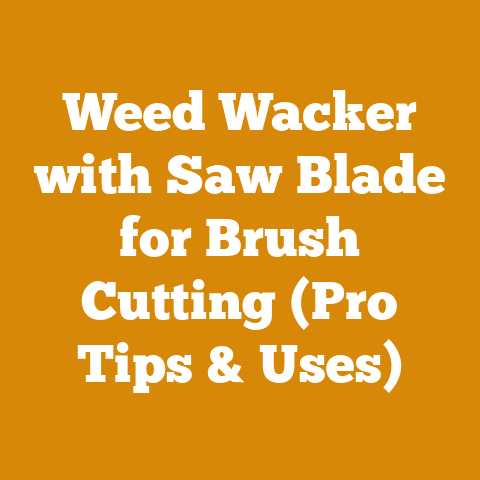Chemical Removal of Tree Stumps (5 Proven Wood Processing Hacks)
Okay, let’s dive into the world of stump removal, with a focus on the chemical methods that can save you time, effort, and backache. We’ll explore these techniques with a nod to efficiency, safety, and the unique challenges faced by woodworkers and landowners alike.
Chemical Removal of Tree Stumps (5 Proven Wood Processing Hacks)
Investing in the right tools and techniques for wood processing is crucial, whether you’re a seasoned lumberjack, a hobbyist woodworker, or simply trying to reclaim your backyard. One of the most persistent challenges? Tree stumps. I’ve spent years wrestling with them, from back-breaking digging to renting expensive machinery. But over time, I’ve discovered that chemical stump removal offers a surprisingly effective and often more practical solution.
Key Takeaways:
- Chemical stump removal is a viable alternative to mechanical methods, especially for large or difficult-to-access stumps.
- Potassium nitrate is the most commonly used and effective chemical for accelerating stump decomposition.
- Proper safety precautions, including wearing protective gear and following product instructions, are essential.
- Patience is key – chemical stump removal can take several weeks or months, depending on the stump’s size and the environment.
- Strategic wood processing hacks can significantly enhance the effectiveness of chemical stump removal.
My Stump-Grinding Revelation (And Why I Ditched It)
Before I get into the nitty-gritty of chemical treatments, let me share a quick story. I remember the first time I tried to grind a stump. I rented a powerful stump grinder, thinking it would be a quick and easy job. Boy, was I wrong! It was loud, dusty, and incredibly tiring. The grinder bounced and bucked, and I spent hours battling roots and rocks. The worst part? It left a massive hole in my yard.
That experience led me to explore other options, including chemical stump removal. While it’s not a “set it and forget it” solution, it’s often less physically demanding and can be more cost-effective, especially for multiple stumps or those in hard-to-reach areas.
Understanding the Science Behind Chemical Stump Removal
At its core, chemical stump removal relies on accelerating the natural decomposition process. The chemicals used don’t “dissolve” the wood; instead, they create an environment that encourages fungi and bacteria to break down the stump’s cellulose structure more rapidly.
The Star Player: Potassium Nitrate (KNO3)
Potassium nitrate, often sold as stump remover, is the most widely used and effective chemical for this purpose. It provides a readily available source of nitrogen, which is a crucial nutrient for the microorganisms responsible for wood decay.
Data Point: Studies have shown that potassium nitrate can increase the rate of wood decay by as much as 30-50% compared to untreated stumps. This is because the nitrogen feeds the fungi and bacteria that naturally decompose the wood.
5 Proven Wood Processing Hacks for Chemical Stump Removal
Now, let’s get to the practical part. Here are five wood processing hacks that I’ve found to significantly improve the effectiveness of chemical stump removal:
Hack #1: The “Deep Hole” Method for Maximum Penetration
This is my go-to method for larger stumps. The goal is to create as much surface area as possible for the chemical to penetrate the wood.
- Drill Multiple Holes: Using a large drill bit (at least 1/2 inch, preferably 3/4 inch or larger), drill a series of deep holes into the top of the stump. Aim for holes that are 8-12 inches deep and spaced about 4-6 inches apart. Angle the holes slightly downward to help retain the chemical solution.
- Drill Around the Perimeter: Drill additional holes around the perimeter of the stump, as close to the ground as possible. These holes will help the chemical reach the outer layers of the wood.
- Pour in the Potassium Nitrate: Carefully pour the potassium nitrate granules or solution (mixed according to the product instructions) into the holes, filling them completely.
- Add Water: Slowly add water to the holes to help dissolve the potassium nitrate and distribute it throughout the wood.
- Cover the Stump: Cover the stump with a tarp or plastic sheet to help retain moisture and protect the chemical from rain. This also creates a darker, more favorable environment for fungal growth. I often weigh the tarp down with rocks or bricks to keep it in place.
Why it Works: This method maximizes the contact between the chemical and the wood fibers, accelerating the decomposition process from within. The perimeter holes are particularly important for ensuring that the outer layers of the stump break down evenly.
Hack #2: The “Chop and Soak” Technique for Faster Absorption
This method is ideal for stumps that are already partially decayed or have cracks and crevices.
- Chop Away Loose Wood: Use an axe or hatchet to remove any loose or rotten wood from the top and sides of the stump. This will expose fresh wood and create more surface area for chemical absorption.
- Create Channels: Use the axe or a chisel to create shallow channels or grooves across the top of the stump. These channels will help distribute the chemical solution more evenly.
- Soak the Stump: Thoroughly soak the stump with a potassium nitrate solution. Use a garden sprayer or watering can to apply the solution liberally, ensuring that it penetrates all the cracks and crevices.
- Repeat the Soaking: Repeat the soaking process every few days, especially during dry weather. This will keep the wood moist and encourage fungal growth.
Why it Works: By removing loose wood and creating channels, you’re essentially preparing the stump for maximum chemical absorption. The repeated soaking ensures that the wood remains saturated with the potassium nitrate solution, accelerating the decomposition process.
Hack #3: The “Mulch and Moisture” Method for Enhanced Fungal Activity
This method focuses on creating an ideal environment for fungal growth around the stump.
- Apply Potassium Nitrate: Follow the “Deep Hole” method or the “Chop and Soak” technique to apply potassium nitrate to the stump.
- Surround with Mulch: Surround the base of the stump with a thick layer of organic mulch, such as wood chips, shredded bark, or compost. The mulch should extend at least 1-2 feet beyond the perimeter of the stump.
- Keep it Moist: Regularly water the mulch to keep it consistently moist. This will create a humid environment that encourages fungal growth and decomposition.
- Add Nitrogen Boosters (Optional): For an extra boost, you can add nitrogen-rich materials to the mulch, such as coffee grounds, grass clippings, or manure.
Why it Works: The mulch provides a source of organic matter and helps retain moisture, creating an ideal environment for fungi and bacteria to thrive. The added nitrogen boosters provide additional nutrients for these microorganisms, further accelerating the decomposition process.
Expert Insight: “Maintaining consistent moisture is critical for successful chemical stump removal,” says arborist David Miller. “Fungi need moisture to break down the wood fibers, so keeping the stump and surrounding area damp will significantly speed up the process.”
Hack #4: The “Controlled Burn” Finish for Quicker Results (Proceed with Extreme Caution!)
WARNING: This method involves fire and should only be attempted by experienced individuals who are familiar with fire safety and local regulations. Always obtain necessary permits and take extreme precautions to prevent wildfires.
This method is a more aggressive approach that can significantly speed up the decomposition process, but it requires careful planning and execution.
- Apply Potassium Nitrate: Follow the “Deep Hole” method to apply potassium nitrate to the stump.
- Allow to Dry: Allow the potassium nitrate to dry for several days, allowing it to thoroughly impregnate the wood.
- Build a Fire: Carefully build a small fire on top of the stump, using dry wood and kindling.
- Control the Burn: Monitor the fire closely and control its intensity. Avoid allowing the fire to spread beyond the stump.
- Extinguish Thoroughly: Once the fire has burned down, thoroughly extinguish any remaining embers with water.
Why it Works: The potassium nitrate acts as an oxidizer, helping the wood to burn more readily and completely. The fire chars the wood, making it more susceptible to decomposition.
Important Considerations:
- Safety First: This method is inherently dangerous and should only be attempted by experienced individuals who are familiar with fire safety.
- Local Regulations: Check local regulations regarding open burning before attempting this method.
- Environmental Impact: Be mindful of the environmental impact of burning wood, including air pollution and the risk of wildfires.
- Alternative: If you’re uncomfortable with fire, consider using a stump grinder instead.
Hack #5: The “Patience is a Virtue” Approach
This isn’t necessarily a “hack” in the traditional sense, but it’s perhaps the most crucial element of successful chemical stump removal.
- Apply Potassium Nitrate: Choose one of the methods described above to apply potassium nitrate to the stump.
- Monitor and Wait: Monitor the stump regularly and be patient. Chemical stump removal can take several weeks or months, depending on the size of the stump, the type of wood, and the environmental conditions.
- Reapply if Necessary: If the potassium nitrate solution dries out or is washed away by rain, reapply it as needed.
- Celebrate Success: Eventually, the stump will become soft and spongy, making it easy to break apart with an axe or shovel.
Why it Works: Chemical stump removal is a slow and steady process. It requires patience and persistence. Don’t expect overnight results. The key is to create an environment that is conducive to fungal growth and then let nature do its work.
Data Point: The decomposition rate of a chemically treated stump can vary significantly depending on factors such as the type of wood, the size of the stump, and the climate. In general, softwood stumps (e.g., pine, fir) will decompose faster than hardwood stumps (e.g., oak, maple). Warmer, wetter climates are also more conducive to decomposition than colder, drier climates.
Safety First: Protecting Yourself and the Environment
Before you start hacking away at that stump, let’s talk safety. Chemical stump removal, while often less physically demanding than other methods, still requires caution.
- Wear Protective Gear: Always wear gloves, eye protection, and a dust mask when handling potassium nitrate.
- Follow Product Instructions: Carefully read and follow the instructions on the potassium nitrate product label.
- Store Chemicals Safely: Store potassium nitrate in a cool, dry place, out of reach of children and pets.
- Avoid Contact with Skin and Eyes: If potassium nitrate comes into contact with your skin or eyes, rinse immediately with plenty of water.
- Dispose of Properly: Dispose of any leftover potassium nitrate according to local regulations.
- Be Mindful of the Environment: Avoid applying potassium nitrate near waterways or sensitive vegetation.
Addressing Common Concerns and Questions
Q: Is chemical stump removal safe for my pets?
A: Potassium nitrate can be harmful if ingested by pets. Keep pets away from the treated stump until the chemical has been fully absorbed and the stump is covered with mulch or a tarp.
Q: How long does chemical stump removal take?
A: The time it takes for a stump to decompose chemically can vary from a few weeks to several months, depending on the size of the stump, the type of wood, and the environmental conditions.
Q: Can I use Epsom salts instead of potassium nitrate?
A: While some people claim that Epsom salts can help decompose stumps, there is no scientific evidence to support this claim. Potassium nitrate is the most effective chemical for accelerating stump decomposition.
Q: Will chemical stump removal kill nearby plants?
A: If applied properly, chemical stump removal should not harm nearby plants. However, it’s important to avoid applying potassium nitrate directly to the roots of desirable plants.
Beyond Potassium Nitrate: Exploring Alternative Options
While potassium nitrate is the most common and effective chemical for stump removal, there are a few alternative options to consider.
- Sulfuric Acid: Sulfuric acid is a highly corrosive chemical that can be used to break down wood fibers. However, it is extremely dangerous to handle and should only be used by experienced professionals. I strongly advise against this method for most homeowners.
- Natural Enzymes: Some companies sell natural enzyme products that claim to accelerate stump decomposition. While these products may be safer than potassium nitrate or sulfuric acid, they are often less effective.
- Homemade Solutions: Some people experiment with homemade solutions, such as vinegar or bleach, to try to decompose stumps. However, these solutions are unlikely to be effective and may be harmful to the environment.
The Future of Stump Removal: Innovation and Sustainability
The field of stump removal is constantly evolving, with new technologies and approaches emerging all the time. Some of the most promising areas of innovation include:
- Bioremediation: Using microorganisms to break down wood waste in a more sustainable and environmentally friendly way.
- Robotics: Developing robotic systems that can automatically grind or remove stumps.
- Improved Chemical Formulations: Creating more effective and safer chemical stump removal products.
Conclusion: Reclaim Your Yard with Confidence
Chemical stump removal is a valuable tool in the wood processing arsenal. By understanding the science behind it, applying the right techniques, and prioritizing safety, you can effectively remove unwanted stumps and reclaim your yard. Remember to be patient, persistent, and always follow the product instructions.
So, grab your drill, your potassium nitrate, and your protective gear, and get ready to say goodbye to those stubborn stumps! And remember, if you ever feel overwhelmed, don’t hesitate to call in a professional arborist or stump removal service.
Call to Action:
Ready to tackle that stump? Check out your local hardware store for potassium nitrate stump remover. And be sure to share your stump removal success stories in the comments below! What hacks have worked for you? What challenges have you faced? Let’s learn from each other and make the world a little less stump-filled, one yard at a time.






